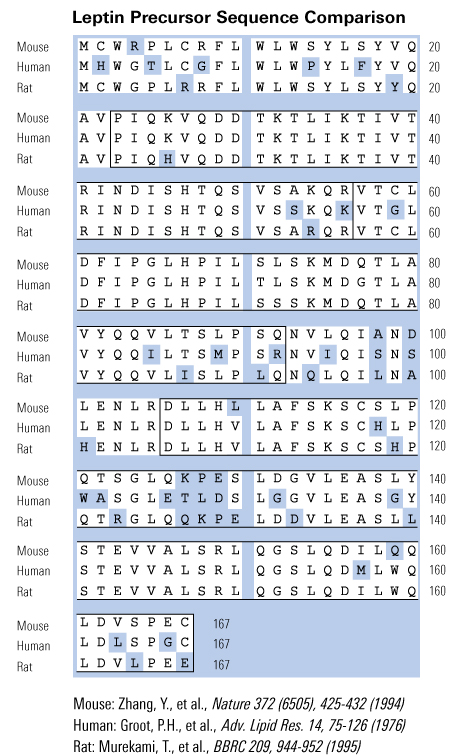Catalog # |
Size |
Price |
|
|---|---|---|---|
| 004-24 | 500 µg | $174 |
 )
)
|
Ser-Cys-Ser-Leu-Pro-Gln-Thr-Ser-Gly-Leu-Gln-Lys-Pro-Glu-Ser-NH2
|
| 1560.7 | |
|
| ≥ 95% |
|
| Exhibits correct molecular weight. |
|
| Soluble in water |
|
|
Up to 6 months in lyophilized form at 0-5°C. |
|
| Each vial contains 500 µg of NET peptide. |

 |
 |
GH secretion is regulated by hypothalamic and peripheral hormones under a very complex interplay. Superimposed on this regulation, signals of a metabolic nature connect GH secretion with the metabolic and energetic homeostasis of a given individual. GH secretion is enhanced in malnutrition and is severely impeded in obesity, but no information is available to explain why GH secretion is severely impeded or blocked in excess adiposity. Obesity is associated with high plasma levels of leptin, and leptin participates at the hypothalamic and pituitary levels in the regulation of GH secretion. Thus, it has been postulated that the inhibitory action of obesity on GH discharge may be mediated by excess leptin levels. The only situation in which obesity does not parallel leptin values is the rare case of morbid obesity due to leptin deficiency caused by missense mutation of the leptin gene. To understand the causes of GH blockade presented in obesity, patients with both homozygous and heterozygous mutations of the leptin gene and matched controls for both sex and body mass index (BMI) were studied. Three homozygous and 5 heterozygous patients with leptin gene mutations as well as 13 control subjects were studied. In all subjects basal levels of leptin and GH values stimulated by the combined administration of GHRH plus GH-releasing peptide-6 (GHRP-6) were analyzed. To analyze the effects of obesity and leptin levels, 5 groups were designed, all them matched by sex and adiposity. The number of subjects (n), leptin levels in micrograms per liter, and adiposity in BMI were as follows: nonobese subjects: n = 5, BMI = 22.1 +/- 0.9 kg/m2, leptin = 5.4 +/- 0.9; heterozygous patients: n = 5, BMI = 27.0 +/- 1.0 kg/m2, leptin = 2.3 +/- 0.1; controls for the heterozygous group: n = 5, BMI = 24.7 +/- 1.1 kg/m2, leptin = 5.7 +/- 1.2; homozygous patients: n = 3, BMI = 54.4 +/- 0.2 kg/m2, leptin = 1.0 +/- 0.2; and controls for the homozygous group: n = 3, BMI = 50.3 +/- 2.0 kg/m2, leptin = 35.0 +/- 6.6. In these matched groups, the GHRH- and GHRP-6-stimulated GH secretion (mean peak +/- SE; micrograms per liter) was: nonobese, 86.8 +/- 8.9 [significantly higher than heterozygous (28.6 +/- 4.9) and control for heterozygous (39.9 +/- 10.4)]; homozygous group, 9.4 +/- 3.0; control for homozygous, 9.3 +/- 1.0 (significantly lower than the heterozygous, control for heterozygous, and nonobese groups). Hence, it appeared that GH discharge was negatively conditioned by adiposity and was not influenced by leptin levels. To further analyze this observation, a correlation analysis showed that GH peaks were negatively correlated with BMI in the 13 control subjects as well as in the 8 leptin-deficient patients. On the contrary, the GH peaks were negatively correlated with leptin levels in controls, but showed the opposite pattern in homo- and heterozygous patients. In conclusion, the GH secretion blockade, which is characteristic of obese states, is due to adiposity or some factor linked to adiposity, but not to elevated plasma leptin levels.
Ozata M, Dieguez C, Casanueva FF. The inhibition of growth hormone secretion presented in obesity is not mediated by the high leptin levels: a study in human leptin deficiency patients. J Clin Endocrinol Metab. 2003;88(1):312-6.

No References
| Catalog# | Product | Size | Price | Buy Now |
|---|
Social Network Confirmation